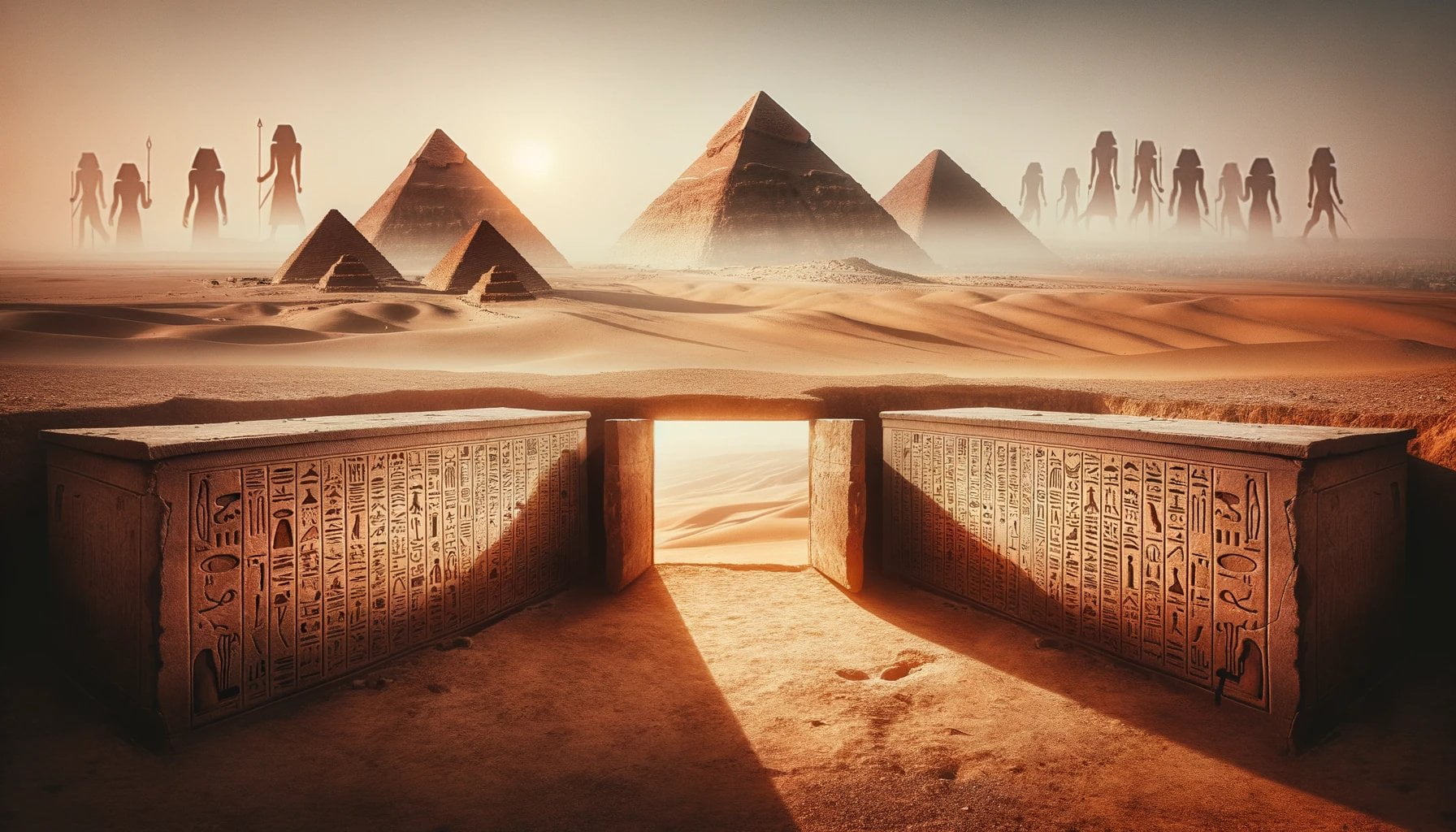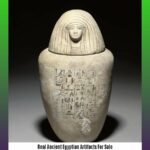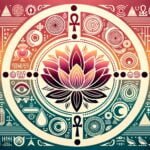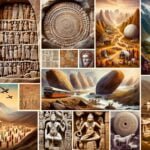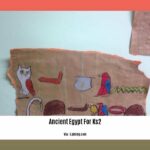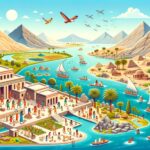Delve into the captivating world of ancient Egypt as we embark on a journey to unravel its enigmatic mysteries. In this article, we will immerse ourselves in the fascinating customs, religious practices, and architectural wonders that have left historians and archaeologists awestruck for centuries. With a deep passion for uncovering the hidden secrets of this remarkable civilization, our exploration will take us beyond the hieroglyphics and ancient artifacts, providing invaluable insights into the captivating mysteries that continue to intrigue and fascinate humanity. Brace yourself for an adventure like no other as we embark on the quest of Unraveling the Mysteries of Ancient Egypt.

Key Takeaways:
- Queen Nefertiti’s disappearance remains a mystery, with her fate and whereabouts unknown.
- The cause of King Tut’s death is still unknown, with theories ranging from murder to disease.
- The location and culture of the trading partner named Punt are shrouded in mystery.
- The labyrinth of Giza, mentioned by ancient writers, has never been found.
- Djedefre’s pyramid near the Giza Plateau was destroyed, leaving behind only fragments.
- The identity of an unknown queen buried in the Valley of the Kings is still a puzzle.
- A possible secret room inside the Great Pyramid at Giza has yet to be explored.
- The origins and purpose of the Great Sphinx continue to baffle researchers.
- Cats held a sacred place in ancient Egyptian society and were mummified and buried with their owners.
- The builders of the pyramids were skilled craftsmen, not slaves, as previously believed.
- The pyramid builders may have suffered from malnutrition due to their limited diet.
- Ancient Egyptians discarded the brain during mummification, valuing the heart as the seat of the soul.
- The ancient Egyptian calendar served as the basis for our modern calendar.
Mysteries of Ancient Egypt
Ancient Egypt has fascinated historians and researchers for centuries with its enigmatic secrets and unsolved mysteries. From the disappearance of iconic figures to the unexplained construction of monumental structures, the ancient civilization continues to captivate our imaginations.
The Disappearance of Queen Nefertiti
Queen Nefertiti, one of the most powerful and beautiful women in ancient Egypt, remains shrouded in mystery. Historians have been unable to determine her exact fate and whereabouts, leaving us to speculate on the possible reasons behind her disappearance. Was she erased from historical records or did she meet an untimely end? The secrets of Queen Nefertiti continue to elude us.
The Death of King Tut
King Tutankhamun, the boy king, gained global attention when his intact tomb was discovered in 1922. However, the cause of his untimely death remains a mystery. Was he murdered, did he suffer an accident, or was his death the result of an illness? Despite numerous theories and investigations, the truth behind King Tut’s demise remains elusive.
The Mysterious Land of Punt
The ancient Egyptians traded with a mysterious land called Punt, known for its exotic resources and valuable goods. But the exact location of Punt has never been conclusively determined. This enigmatic land continues to puzzle historians and researchers, adding a sense of intrigue to ancient Egyptian trade routes.
The Labyrinth of Giza
Ancient texts describe a labyrinth near the Giza Plateau, believed to contain temples and chambers, possibly serving as burial sites for pharaohs. However, despite extensive searches and excavations, the labyrinth remains undiscovered. Its existence raises questions about the hidden corridors and chambers that may still lie beneath the desert sands.
The Destroyed Pyramid of Djedefre
Djedefre, son of Khufu, constructed his own pyramid near the Giza Plateau. However, this pyramid was later destroyed, leaving behind only fragments and traces. The reasons behind its destruction and the exact location of this pyramid remain a mystery. Exploring the remains of Djedefre’s pyramid may provide valuable insights into ancient Egyptian architecture and construction techniques.
The Unknown Queen
In the Valley of the Kings, a hidden chamber was discovered containing the sarcophagus of an unknown queen. The identity of this queen and her connection to the ruling dynasties of ancient Egypt remains a puzzle waiting to be solved. Analyzing the chamber and its contents could shed light on this mysterious figure and the role she played in ancient Egyptian history.
The Hidden Chamber at Giza
A non-invasive scan conducted in 2015 detected a possible hidden chamber within the Great Pyramid at Giza. The purpose and contents of this chamber are still unknown, fueling excitement and speculation among researchers. Further exploration is necessary to uncover the secrets that may lie within this mysterious chamber.
The Great Sphinx
The Great Sphinx, with its enigmatic human head and lion body, stands as a symbol of mystery and intrigue. Its origins, purpose, and the identity of those who built it remain unanswered questions. Who carved this colossal statue, when was it created, and what significance does it hold? The Great Sphinx continues to challenge our understanding of ancient Egyptian civilization.
The Egyptians’ Love for Cats
Ancient Egyptians held a deep reverence for cats, considering them sacred animals. They were even mummified and buried alongside their owners, showcasing the unique relationship between humans and felines in ancient Egypt. Understanding the cultural practices and beliefs surrounding cats provides valuable insights into the daily lives of the ancient Egyptians.
The Builders of the Pyramids
Contrary to popular belief, the builders of the pyramids were not slaves but skilled craftsmen. Graffiti and records found near the pyramids suggest that these builders took pride in their work and left their mark on these monumental structures. Exploring the lives and techniques of the pyramid builders offers a glimpse into the intricacies of ancient Egyptian construction.
The Food of the Egyptian Mystery Builders
Studies have revealed that the diet of the pyramid builders consisted mainly of meat, bread, beer, and vegetables. However, the limited variety in their diet may have resulted in malnutrition and disease among these skilled workers. Examining the food habits of ancient Egyptians sheds light on the challenges they faced and the impact of their diet on their daily lives.
The Unimportance of the Human Brain
In the process of mummification, ancient Egyptians discarded the brain, considering it unimportant. Instead, they preserved the heart as the seat of the soul. This cultural practice reflects their understanding of the human body and spirituality, offering insights into ancient Egyptian beliefs and rituals.
The Modern Calendar
The modern calendar we use today is rooted in the ancient Egyptian calendar. With 365 days divided into 12 months and three seasons, the ancient Egyptians laid the foundation for our current timekeeping system. Acknowledging this ancient influence on our daily lives highlights the lasting impact of Egyptian culture and civilization.
Ancient Egypt’s mysteries continue to fascinate and intrigue us, as we explore the unknown and unravel the enigmatic secrets of this remarkable civilization. With each new discovery and investigation, we come closer to understanding the complexities and wonders of ancient Egyptian history.
The supreme god of ancient Egypt was believed to be the ultimate ruler of the gods and the universe. Learn more about the fascinating mythology surrounding the supreme god of ancient Egypt here.
Magic played a significant role in ancient Egyptian culture. Delve into the mystical world of ancient Egypt and discover the secrets of their magical practices here.
Explore the ten laws that governed ancient Egyptian society and shaped their civilization. Uncover the fascinating principles that guided the lives of the ancient Egyptians here.
Birds held a special place in the hearts of ancient Egyptians, with many species being venerated and worshipped. Discover the significance of birds in ancient Egyptian culture here.
The crocodile god, Sobek, played an intriguing role in ancient Egyptian mythology. Uncover the legends and stories surrounding this powerful deity here.
Did you know that ancient Egyptians were known to use toothpaste? Learn about the early forms of dental care in ancient Egypt here.
While ancient Egypt was a remarkable civilization, they had their own set of challenges and flaws. Explore some of the dark aspects of ancient Egyptian society here.
Black cats held a special significance in ancient Egyptian culture and were even worshipped as divine creatures. Discover the mystical connection between black cats and ancient Egypt here.
From Hatshepsut to Cleopatra, ancient Egypt was home to many powerful and influential queens. Learn about the remarkable women who ruled as queens of Egypt here.
Snakes were both feared and revered in ancient Egypt, playing a prominent role in their mythology and religious practices. Uncover the symbolism and significance of snakes in ancient Egyptian culture here.
The Curse of the Tutankhamun: A Mysterious Trail of Misfortune
Ancient Egypt has always fascinated humanity with its rich history and enigmatic secrets. Amongst the numerous mysteries that surround this remarkable civilization, one that continues to captivate our imaginations is the Curse of the Tutankhamun. Believed to bring misfortune and tragedy to those who disturb the mummy of an ancient Egyptian, especially a pharaoh, this curse has garnered widespread attention since the discovery of King Tutankhamun’s tomb in 1922.
The story of the Curse of King Tutankhamun begins with the British archaeologist Howard Carter and his friend Lord Carnarvon, who uncovered the pharaoh’s tomb in the Valley of the Kings. Their excavation was accompanied by a series of untimely deaths, including Lord Carnarvon himself, leading to rumors of a curse. Yet, the reality behind these incidents remains a subject of debate.
Some attribute the deaths to natural causes, such as infections from mosquito bites, which were prevalent in the region at the time. Others propose theories of coincidence, linking the deaths to individuals who were already in poor health or engaged in risky behaviors. Despite these explanations, the allure of the curse persists, adding to the mystique surrounding King Tutankhamun and his burial.
Modern examinations of King Tut’s remains have shed light on a possible cause for his death, as a fracture in his skull suggests foul play or an accident. This discovery has prompted further speculation surrounding the Curse of the Tutankhamun, questioning its supernatural nature.
The true origin and purpose of the curse remain elusive. Some argue that the idea of the curse was propagated to deter potential grave robbers and protect the archaeological treasures of ancient Egypt. Others propose that disturbing the sacred resting place of a pharaoh could invoke divine retribution, tied to the religious beliefs and superstitions of the time.
Regardless of the truth behind the curse, the fascination with the Curse of the Tutankhamun endures, serving as a window into ancient beliefs and the enduring allure of the unknown. It continues to capture the imaginations of historians, archaeologists, and enthusiasts alike, as we strive to unravel the mysteries of ancient Egypt.
Key Takeaways:
– The Curse of the Tutankhamun is a subject of fascination and speculation surrounding the discovery of King Tut’s tomb.
– The deaths associated with the curse remain a topic of debate, with some attributing them to natural causes.
– Modern examinations of King Tut’s remains offer alternative explanations for his death, raising questions about the curse’s supernatural nature.
– The true origin and purpose of the curse are still unknown, with theories ranging from deterrence to divine retribution.
– The enduring allure of the curse reflects the timeless appeal of ancient Egypt and its mysterious wonders.
Sources:
– Live Science: The Curse of King Tut: Facts & Fable
– Wikipedia: Curse of the pharaohs
The Book of the Dead: A Guide to the Afterlife in Ancient Egypt
The Book of the Dead is an ancient Egyptian collection of spells and guides that served as a roadmap for the souls of the deceased to navigate the afterlife. Also known as “The Book of Coming Forth by Day” or “Spells for Going Forth by Day,” this remarkable text provides us with a fascinating glimpse into ancient Egyptian beliefs and practices surrounding death and the afterlife.
Written on papyrus scrolls with accompanying illustrations called vignettes, the Book of the Dead was an essential part of funeral ceremonies. A priest would recite the spells and rituals, offering guidance and protection for the deceased as they embarked on their journey through the afterlife. One of the most notable examples of this ancient text is the Papyrus of Ani, which is considered to be the finest extant example of the Book of the Dead.
This extraordinary collection of spells touches upon various themes related to the afterlife. It includes the trial of the heart, where the deceased’s heart is weighed against the feather of Ma’at, the goddess of truth and justice. If the individual’s heart is found to be righteous, they are granted a blissful existence in the afterlife. The spells and rituals described in the Book of the Dead provided the deceased with the necessary instructions and tools for successfully navigating the challenges they would face in the world beyond.
The discovery and preservation of the Book of the Dead has provided us with valuable insights into ancient Egyptian burial traditions and beliefs. Many copies of the book have been found in tombs, a testament to its importance in ancient Egyptian society. Scholars and researchers continue to study and interpret the Book of the Dead to deepen our understanding of this remarkable civilization.
Intrigued to learn more about the Book of the Dead and its significance in ancient Egypt? Check out these reputable sources:
- World History Encyclopedia – Egyptian Book of the Dead
- National Geographic – The Book of the Dead was Egyptians’ Inside Guide to the Underworld
Key Takeaways:
– The Book of the Dead served as a guide for the souls of the deceased to navigate the afterlife in ancient Egypt.
– It was written on papyrus scrolls with accompanying illustrations and recited by priests during funeral ceremonies.
– The book covers various themes, including the trial of the heart and the rewards of the afterlife, offering insight into ancient Egyptian beliefs.
– The preservation and discovery of the Book of the Dead have provided valuable insights into ancient Egyptian burial traditions.
– Many copies of the book have been found in tombs, demonstrating its significance in ancient Egyptian society.
– Scholars and researchers continue to study and interpret the Book of the Dead to gain a deeper understanding of ancient Egyptian civilization.
The Unsolved Riddle of the Hieroglyphics: Deciphering Ancient Egyptian Writing
Hieroglyphics have fascinated historians and researchers for centuries, representing a mysterious and complex form of ancient Egyptian writing. The decipherment of these intricate symbols was a monumental achievement that revolutionized our understanding of ancient Egypt. In this article, we will delve into the intriguing journey of decoding hieroglyphics and uncover the secrets they hold.
The Rosetta Stone: A Key to Unlock the Past
One significant breakthrough in deciphering hieroglyphics came with the discovery of the Rosetta Stone in 1799 by French soldiers during Napoleon’s invasion of Egypt. This stone, inscribed with three different scripts – hieroglyphics, demotic, and Greek – became the key that unlocked the ancient Egyptian language.
Renowned scholar Jean-François Champollion took up the challenge of unraveling the hieroglyphic code. His deep fascination with the Coptic language, an ancient Egyptian form of writing used by early Christians, played a pivotal role in his decipherment journey. By comparing hieroglyphic symbols with their Coptic counterparts, Champollion gradually pieced together the intricate puzzle of hieroglyphics.
The Race to Decipher Ancient Egyptian Writing
The decipherment of hieroglyphics was not a solo endeavor but a race among passionate scholars. Thomas Young, a British polymath, made significant contributions to the understanding of hieroglyphic writing alongside Champollion. Their combined efforts and relentless pursuit of knowledge led to groundbreaking breakthroughs.
Over a span of more than 20 years, Champollion meticulously studied and analyzed the Rosetta Stone, hieroglyphic inscriptions in temples and tombs, and other ancient artifacts. His efforts paid off when he successfully unlocked the meanings behind these enigmatic symbols, shedding light on the religious practices, daily life, and rich history of ancient Egypt.
Deciphering the Hieroglyphic System
Ancient Egyptian hieroglyphics were not simply a written language but a complex system of signs and symbols. Hieroglyphics encompassed both ideograms, representing ideas or concepts, and phonetic signs, representing sounds. This intricate combination made deciphering hieroglyphics a challenging task.
Champollion’s breakthrough came in understanding that some hieroglyphic signs represented sounds and could be used to spell out ancient Egyptian words. By linking these phonetic values to the corresponding hieroglyphic symbols, he was able to read and understand the ancient Egyptian texts like never before.
The Legacy of Deciphered Hieroglyphics
The decipherment of hieroglyphics opened up an invaluable treasure trove of knowledge about ancient Egyptian civilization. It provided insights into their religious beliefs, cosmology, royal lineage, and societal structures. With this newfound understanding, historians could reconstruct the narrative of Egypt’s glorious past.
Not only did the decipherment revolutionize our understanding of ancient Egypt, but it also fostered new avenues of research and exploration. It allowed archaeologists to accurately interpret inscriptions found in various ancient Egyptian sites, unlocking hidden meanings and shedding light on previously unknown aspects of this awe-inspiring civilization.
Key Takeaways:
- The Rosetta Stone, discovered during Napoleon’s invasion of Egypt, played a crucial role in deciphering hieroglyphics.
- Jean-François Champollion’s fascination with the Coptic language contributed to his decipherment journey.
- Deciphering hieroglyphics was a race among scholars, with Champollion and Thomas Young making significant contributions.
- Ancient Egyptian hieroglyphics were a complex combination of ideograms and phonetic signs.
- The decipherment of hieroglyphics unveiled a wealth of knowledge about ancient Egyptian civilization and culture.
Sources:
- National Geographic: “Hieroglyphics were a mystery until this man solved the riddle of the Rosetta Stone”
- BBC History – Ancient History in depth: “The Decipherment of Hieroglyphs”
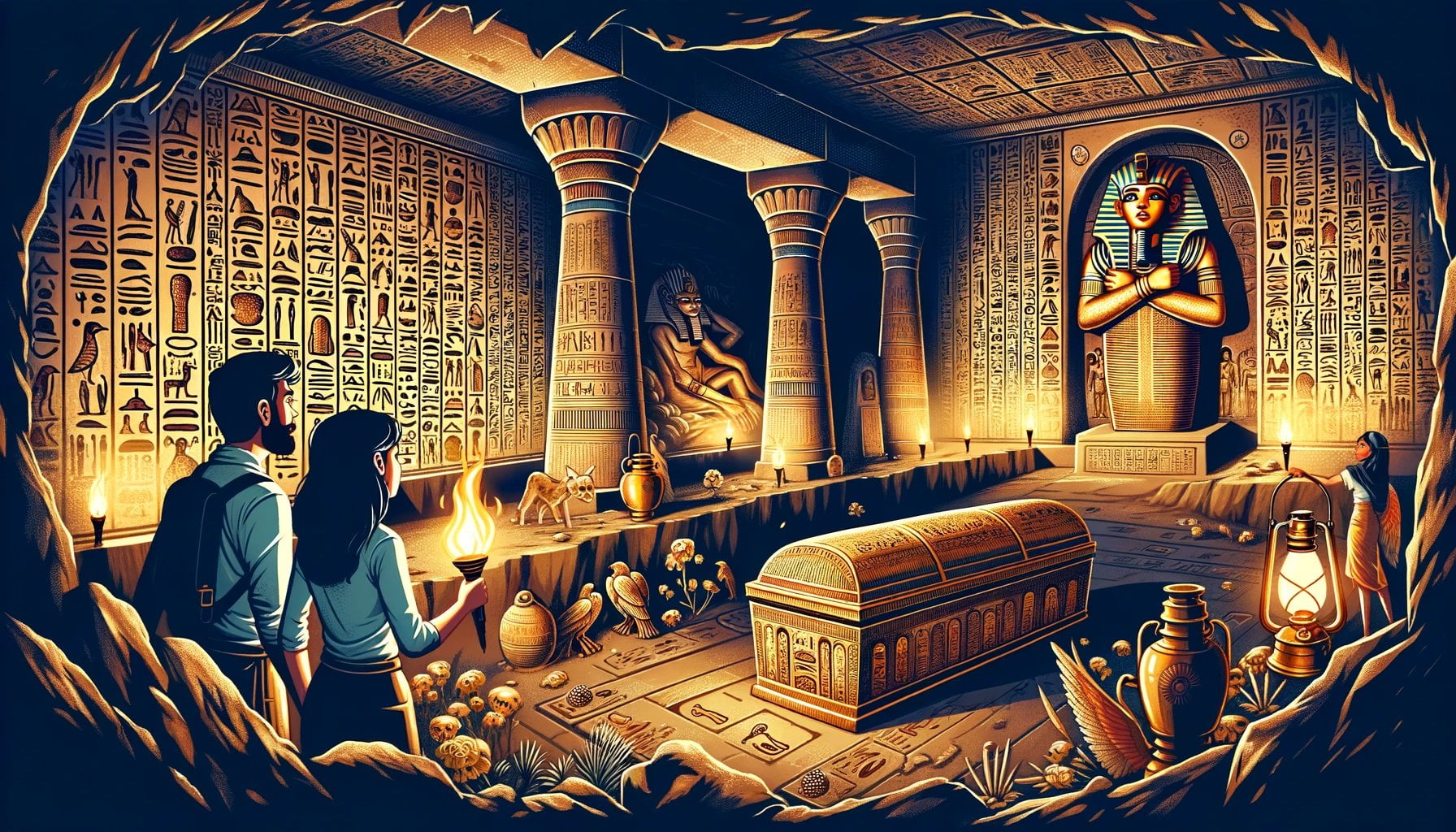
FAQ
Q1: What are some of the intriguing mysteries of ancient Egypt?
A1: Some intriguing mysteries of ancient Egypt include the disappearance of Queen Nefertiti, the death of King Tut, the mysterious land of Punt, the undiscovered labyrinth of Giza, the destroyed pyramid of Djedefre, the unknown queen in the Valley of the Kings, the hidden chamber at Giza, the Great Sphinx, the Egyptians’ love for cats, the builders of the pyramids, the food of the Egyptian mystery builders, the unimportance of the human brain, and the influence of ancient Egypt on the modern calendar.
Q2: What is the Curse of King Tutankhamun?
A2: The Curse of King Tutankhamun is a subject of fascination and speculation. It is believed that those who violated his tomb faced a curse, resulting in bad luck, illness, or even death. The curse gained popularity after the discovery of King Tut’s tomb in 1922, and the deaths of individuals connected to the excavation fueled rumors of the curse. However, the existence of the curse remains a topic of debate.
Q3: What is the Book of the Dead?
A3: The Book of the Dead is an ancient Egyptian collection of spells and guides that served as a roadmap for the souls of the deceased to navigate the afterlife. It was written on papyrus scrolls and often included illustrations called vignettes. The book provided instructions and protection for the deceased as they made their journey through the afterlife.
Q4: Who deciphered the code of the Rosetta Stone?
A4: Jean-François Champollion deciphered the code of the Rosetta Stone, which played a crucial role in deciphering ancient Egyptian hieroglyphics. His fascination with the related ancient language Coptic contributed to his decipherment.
Q5: What is the significance of the decipherment of hieroglyphics?
A5: The decipherment of hieroglyphics by Champollion and other scholars opened up a wealth of knowledge about ancient Egyptian civilization and culture. It allowed for a deeper understanding of their written records, religious beliefs, and daily life.
“`json
“`
- Sept 31 Myth: Unveiling Calendar Secrets - March 18, 2025
- How Long & Till December 18, 2025: Accurate Countdown Guide - March 18, 2025
- Discover Japanese Artists: A Complete History - March 18, 2025
